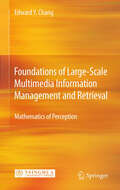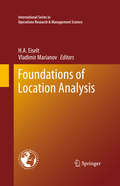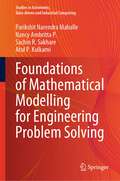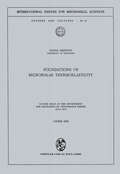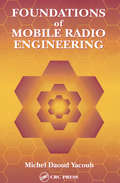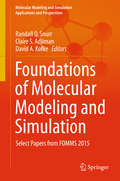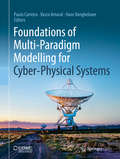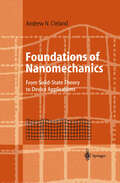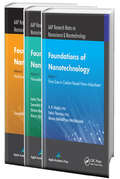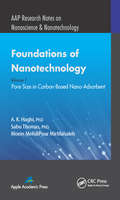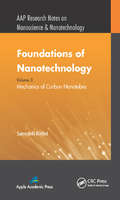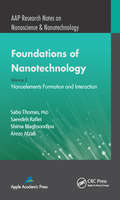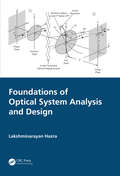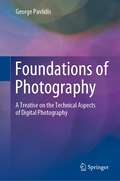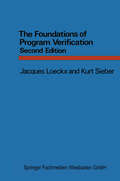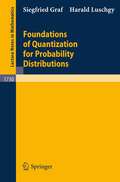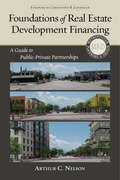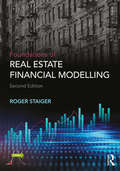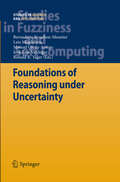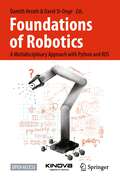- Table View
- List View
Foundations of Large-Scale Multimedia Information Management and Retrieval: Mathematics of Perception
by Edward Y. Chang"Foundations of Large-Scale Multimedia Information Management and Retrieval: Mathematics of Perception" covers knowledge representation and semantic analysis of multimedia data and scalability in signal extraction, data mining, and indexing. The book is divided into two parts: Part I - Knowledge Representation and Semantic Analysis focuses on the key components of mathematics of perception as it applies to data management and retrieval. These include feature selection/reduction, knowledge representation, semantic analysis, distance function formulation for measuring similarity, and multimodal fusion. Part II - Scalability Issues presents indexing and distributed methods for scaling up these components for high-dimensional data and Web-scale datasets. The book presents some real-world applications and remarks on future research and development directions. The book is designed for researchers, graduate students, and practitioners in the fields of Computer Vision, Machine Learning, Large-scale Data Mining, Database, and Multimedia Information Retrieval.Dr. Edward Y. Chang was a professor at the Department of Electrical & Computer Engineering, University of California at Santa Barbara, before he joined Google as a research director in 2006. Dr. Chang received his M.S. degree in Computer Science and Ph.D degree in Electrical Engineering, both from Stanford University.
Foundations of Location Analysis (International Series in Operations Research & Management Science #155)
by H. A. Eiselt Vladimir MarianovLocation analysis has matured from an area of theoretical inquiry that was designed to explain observed phenomena to a vibrant field which can be and has been used to locate items as diverse as landfills, fast food outlets, gas stations, as well as politicians and products in issue and feature spaces. Modern location science is dealt with by a diverse group of researchers and practitioners in geography, economics, operations research, industrial engineering, and computer science. Given the tremendous advances location science has seen from its humble beginnings, it is time to look back. The contributions in this volume were written by eminent experts in the field, each surveying the original contributions that created the field, and then providing an up-to-date review of the latest contributions. Specific areas that are covered in this volume include: • The three main fields of inquiry: minisum and minimax problems and covering models • Nonstandard location models, including those with competitive components, models that locate undesirable facilities, models with probabilistic features, and problems that allow interactions between facilities • Descriptions and detailed examinations of exact techniques including the famed Weiszfeld method, and heuristic methods ranging from Lagrangean techniques to Greedy algorithms • A look at the spheres of influence that the facilities generate and that attract customers to them, a topic crucial in planning retail facilities • The theory of central places, which, other than in mathematical games, where location science was born
Foundations of Mathematical Modelling for Engineering Problem Solving (Studies in Autonomic, Data-driven and Industrial Computing)
by Parikshit Narendra Mahalle Nancy Ambritta P. Sachin R. Sakhare Atul P. KulkarniThis book aims at improving the mathematical modelling skills of users by enhancing the ability to understand, connect, apply and use the mathematical concepts to the problem at hand. This book provides the readers with an in-depth knowledge of the various categories/classes of research problems that professionals, researchers and students might encounter following which the applications of appropriate mathematical models is explained with the help of case studies. The book is targeted at academicians, researchers, students and professionals who belong to all engineering disciplines.
Foundations of Medical Physics
by George Starkschall Victor J. MontemayorCovering topics in Radiobiology, Modern Physics, Medical Imaging and Radiation Therapy, Foundations of Medical Physics serves as an introduction to the field of Medical Physics, or Radiation Oncology Physics.An overview of the history of cancer and cancer treatment along with a brief introduction to the fundamental principles of Radiobiology constitute Part I of this book, which serves as the motivation for the principles of Radiation Therapy, or cancer treatment with radiation. Part II contains the fundamental ideas from Modern Physics that form the foundation for an understanding of the approaches to treatment used in Radiation Therapy. Finally, Part III shows the applications of Parts I and II to Medical Imaging and Radiation Therapy. This unusual introduction to Medical Physics is aimed at undergraduate physics majors along with other science majors who have taken at least one year of Physics and one year of calculus, although Medical Physics graduate students and radiation oncology residents may find this different approach to the subject illuminating. This text assumes that the instructor is a physicist who does not necessarily have a background in Medical Physics.
Foundations of Medical Physics
by George Starkschall Victor J. MontemayorCovering topics in Radiobiology, Modern Physics, Medical Imaging and Radiation Therapy, Foundations of Medical Physics serves as an introduction to the field of Medical Physics, or Radiation Oncology Physics.An overview of the history of cancer and cancer treatment along with a brief introduction to the fundamental principles of Radiobiology constitute Part I of this book, which serves as the motivation for the principles of Radiation Therapy, or cancer treatment with radiation. Part II contains the fundamental ideas from Modern Physics that form the foundation for an understanding of the approaches to treatment used in Radiation Therapy. Finally, Part III shows the applications of Parts I and II to Medical Imaging and Radiation Therapy. This unusual introduction to Medical Physics is aimed at undergraduate physics majors along with other science majors who have taken at least one year of Physics and one year of calculus, although Medical Physics graduate students and radiation oncology residents may find this different approach to the subject illuminating. This text assumes that the instructor is a physicist who does not necessarily have a background in Medical Physics.
Foundations of Micropolar Thermoelasticity: Course held at the Department for Mechanics of Deformable Bodies July 1970 (CISM International Centre for Mechanical Sciences #23)
by Cemal EringenFoundations of Mobile Radio Engineering
by Michel Daoud YacoubFoundations of Mobile Radio Engineering is a comprehensive survey covering the main topics of mobile radio systems. Concepts considered include the theory of patterns and symmetry and how it impacts hexagonal cell tessellation, long-term fading and log-normal distribution, short-term fading and Rayleigh distribution, indoor propagation and Rice dis
Foundations of Mobile Radio Engineering
by Michel Daoud YacoubFoundations of Mobile Radio Engineering is a comprehensive survey covering the main topics of mobile radio systems. Concepts considered include the theory of patterns and symmetry and how it impacts hexagonal cell tessellation, long-term fading and log-normal distribution, short-term fading and Rayleigh distribution, indoor propagation and Rice dis
Foundations of Molecular Modeling and Simulation: Select Papers from FOMMS 2015 (Molecular Modeling and Simulation)
by Randall Q. Snurr Claire S. Adjiman David A. KofkeThis book is a collection of select proceedings of the FOMMS 2015 conference. FOMMS 2015 was the sixth triennial FOMMS conference showcasing applications of theory of computational quantum chemistry, molecular science, and engineering simulation. The theme of the 2015 meeting was on Molecular Modeling and the Materials Genome. This volume comprises chapters on many distinct applications of molecular modeling techniques. The content will be useful to researchers and students alike.
Foundations of Multi-Paradigm Modelling for Cyber-Physical Systems
This open access book coherently gathers well-founded information on the fundamentals of and formalisms for modelling cyber-physical systems (CPS). Highlighting the cross-disciplinary nature of CPS modelling, it also serves as a bridge for anyone entering CPS from related areas of computer science or engineering.Truly complex, engineered systems—known as cyber-physical systems—that integrate physical, software, and network aspects are now on the rise. However, there is no unifying theory nor systematic design methods, techniques or tools for these systems. Individual (mechanical, electrical, network or software) engineering disciplines only offer partial solutions. A technique known as Multi-Paradigm Modelling has recently emerged suggesting to model every part and aspect of a system explicitly, at the most appropriate level(s) of abstraction, using the most appropriate modelling formalism(s), and then weaving the results together to form a representation of the system. If properly applied, it enables, among other global aspects, performance analysis, exhaustive simulation, and verification. This book is the first systematic attempt to bring together these formalisms for anyone starting in the field of CPS who seeks solid modelling foundations and a comprehensive introduction to the distinct existing techniques that are multi-paradigmatic. Though chiefly intended for master and post-graduate level students in computer science and engineering, it can also be used as a reference text for practitioners.
Foundations of Nanomechanics: From Solid-State Theory to Device Applications (Advanced Texts in Physics)
by Andrew N. ClelandThis text provides an introduction, at the level of an advanced student in engineering or physics, to the field of nanomechanics and nanomechanical devices. It provides a unified discussion of solid mechanics, transducer applications, and sources of noise and nonlinearity in such devices. Demonstrated applications of these devices, as well as an introduction to fabrication techniques, are also discussed. The text concludes with an overview of future technologies, including the potential use of carbon nanotubes and other molecular assemblies.
Foundations of Nanotechnology - Three Volume Set
by A. K. Haghi Sabu Thomas Moein MehdiPour MirMahaleh Saeedeh Rafiei Shima Maghsoodlou Arezo AfzaliNanoscale science, engineering, and technology-commonly referred to collectively as nanotechnology-is believed by many to offer extraordinary economic and societal benefits. Nanotechnology is generally defined as the ability to create and use materials, devices, and systems with unique properties at the scale of approximately 1 to 100 nm. Nanotechn
Foundations of Nanotechnology, Volume One: Pore Size in Carbon-Based Nano-Adsorbents
by A. K. Haghi Sabu Thomas Moein MehdiPour MirMahalehThis volume covers a wide range of adsorption activities of porous carbon (PC), CNTs, and carbon nano structures that have been employed so far for the removal of various pollutants from water, wastewater, and organic compounds. The low cost, high efficiency, simplicity, and ease in the upscaling of adsorption processes using PC make the adsorption
Foundations of Nanotechnology, Volume Three: Mechanics of Carbon Nanotubes
by Saeedeh RafieiIn this research notes book, the modelling of mechanical properties of CNT/polymer nanocomposites is presented. The book begins with the structural and intrinsic mechanical properties of CNTs and then introduces computational methods that have been applied to polymer nanocomposites, covering from molecular scale (molecular dynamics, Monte Carlo), m
Foundations of Nanotechnology, Volume Two: Nanoelements Formation and Interaction
by Sabu Thomas Saeedeh Rafiei Shima Maghsoodlou Arezo AfzaliThe collection of topics in this book reflects the diversity of recent advances in nanoelements formation and interactions in nanosystems with a broad perspective that is useful for scientists as well as for graduate students and engineers. One of the main tasks in making nanocomposites is building the dependence of the structure and shape of the n
Foundations of Optical System Analysis and Design
by Lakshminarayan HazraSince the incorporation of scientific approach in tackling problems of optical instrumentation, analysis and design of optical systems constitute a core area of optical engineering. A large number of software with varying level of scope and applicability is currently available to facilitate the task. However, possession of an optical design software, per se, is no guarantee for arriving at correct or optimal solutions. The validity and/or optimality of the solutions depend to a large extent on proper formulation of the problem, which calls for correct application of principles and theories of optical engineering. On a different note, development of proper experimental setups for investigations in the burgeoning field of optics and photonics calls for a good understanding of these principles and theories. With this backdrop in view, this book presents a holistic treatment of topics like paraxial analysis, aberration theory, Hamiltonian optics, ray-optical and wave-optical theories of image formation, Fourier optics, structural design, lens design optimization, global optimization etc. Proper stress is given on exposition of the foundations. The proposed book is designed to provide adequate material for ‘self-learning’ the subject. For practitioners in related fields, this book is a handy reference. Foundations of Optical System Analysis and Synthesis provides A holistic approach to lens system analysis and design with stress on foundations Basic knowledge of ray and wave optics for tackling problems of instrumental optics Proper explanation of approximations made at different stages Sufficient illustrations for facilitation of understanding Techniques for reducing the role of heuristics and empiricism in optical/lens design A sourcebook on chronological development of related topics across the globe This book is composed as a reference book for graduate students, researchers, faculty, scientists and technologists in R & D centres and industry, in pursuance of their understanding of related topics and concepts during problem solving in the broad areas of optical, electro-optical and photonic system analysis and design.
Foundations of Optical System Analysis and Design
by Lakshminarayan HazraSince the incorporation of scientific approach in tackling problems of optical instrumentation, analysis and design of optical systems constitute a core area of optical engineering. A large number of software with varying level of scope and applicability is currently available to facilitate the task. However, possession of an optical design software, per se, is no guarantee for arriving at correct or optimal solutions. The validity and/or optimality of the solutions depend to a large extent on proper formulation of the problem, which calls for correct application of principles and theories of optical engineering. On a different note, development of proper experimental setups for investigations in the burgeoning field of optics and photonics calls for a good understanding of these principles and theories. With this backdrop in view, this book presents a holistic treatment of topics like paraxial analysis, aberration theory, Hamiltonian optics, ray-optical and wave-optical theories of image formation, Fourier optics, structural design, lens design optimization, global optimization etc. Proper stress is given on exposition of the foundations. The proposed book is designed to provide adequate material for ‘self-learning’ the subject. For practitioners in related fields, this book is a handy reference. Foundations of Optical System Analysis and Synthesis provides A holistic approach to lens system analysis and design with stress on foundations Basic knowledge of ray and wave optics for tackling problems of instrumental optics Proper explanation of approximations made at different stages Sufficient illustrations for facilitation of understanding Techniques for reducing the role of heuristics and empiricism in optical/lens design A sourcebook on chronological development of related topics across the globe This book is composed as a reference book for graduate students, researchers, faculty, scientists and technologists in R & D centres and industry, in pursuance of their understanding of related topics and concepts during problem solving in the broad areas of optical, electro-optical and photonic system analysis and design.
Foundations of Photography: A Treatise on the Technical Aspects of Digital Photography
by George PavlidisThis book offers an in-depth technical presentation of photography and details about the inner workings of the digital camera, while keeping the artistic principles in mind. Departing from the current stream, the book treats photography as a highly scientific and technical subject, and serves as a reference to those who seek for an understanding of the technical aspects relating to the photographic camera, the beating heart of photography. It offers insight on why the photographs are created the way they are, highlighting also the limitations. As the author of this book is an image technology scientist and a photography enthusiast who has been teaching photography for a long time, this treatise reflects his own constant search and study for an in-depth understanding.
Foundations of Quantization for Probability Distributions (Lecture Notes in Mathematics #1730)
by Siegfried Graf Harald LuschgyDue to the rapidly increasing need for methods of data compression, quantization has become a flourishing field in signal and image processing and information theory. The same techniques are also used in statistics (cluster analysis), pattern recognition, and operations research (optimal location of service centers). The book gives the first mathematically rigorous account of the fundamental theory underlying these applications. The emphasis is on the asymptotics of quantization errors for absolutely continuous and special classes of singular probabilities (surface measures, self-similar measures) presenting some new results for the first time. Written for researchers and graduate students in probability theory the monograph is of potential interest to all people working in the disciplines mentioned above.
Foundations of Real Estate Development Financing: A Guide to Public-Private Partnerships (Metropolitan Planning + Design Ser.)
by Arhur C. NelsonAmerican’s landscape is undergoing a profound transformation as demand grows for a different kind of American Dream--smaller homes on smaller lots, multifamily options, and walkable neighborhoods. This trend presents a tremendous opportunity to reinvent our urban and suburban areas. But in a time of fiscal austerity, how do we finance redevelopment needs? In Foundations of Real Estate Development Finance: A Guide for Public-Private Partnerships, urban scholar Arthur C. Nelson argues that efficient redevelopment depends on the ability to leverage resources through partnerships. Public-private partnerships are increasingly important in reducing the complexity and lowering the risk of redevelopment projects. Although planners are in integral part of creating these partneships, their training does generally not include real-estate finacing, which presents challenges and imbalances in public-private partnership.This is the first primer on financing urban redevelopment written for practicing planners and public administrators. In easy-to-understand language, it will inform readers of the natural cycle of urban development, explain how to overcome barriers to efficient redevelopment, what it takes for the private sector to justify its redevelopment investments, and the role of public and nonprofit sectors to leverage private sector redevelopment where the market does not generate sufficient rates of return.This is a must read for practicing planners and planning students, economic development officials, public administrators, and others who need to understand how to leverage public and non-profit resources to leverage private funds for redevelopment.
Foundations of Real Estate Financial Modelling
by Roger StaigerFoundations of Real Estate Financial Modelling, Second Edition is specifically designed to provide the scalable basis of pro forma modelling for real estate projects. The book introduces students and professionals to the basics of real estate finance theory prior to providing a step-by-step guide for financial real estate model construction using Excel. The book introduces an innovative new financial metric, P(Gain), which quantifies the probability of a Return of Capital and answers the most basic question for investing, "What is the probability I get my money back?".? This new second edition has been fully revised and expanded. The book is separated into three functional units: (1) Real Estate Valuation Basics, Theory and Skills, (2) Real Estate Pro Forma Modelling, (3) Real Estate Pro Forma (Enhancements). New and enhanced Chapters cover:? Interest rates Amortization Single- and multi-family unit Development module Rent roll module Waterfall (equity bifurcation) Hotel, retail/office and townhouse. ? In addition, this new edition includes problem sets and solutions at the end of each chapter as well as case studies underpinning the chapter topics. Further chapters are dedicated to risk quantification and include scenario, stochastic and Monte Carlo simulations, equity waterfalls, and adding U.S. GAAP financial statements to existing real estate pro forma models. This book is the ideal textbook for a Real Estate Finance class, providing the theoretical basis of real estate finance as well as valuable modelling skills for the workplace. This book provides individuals with a step-by-step instruction on how to construct a real estate financial model starting with a new spreadsheet. The resultant model is portable, scalable, and modular. A companion website provides the pro forma models to readers as a reference for their own constructed models.
Foundations of Real Estate Financial Modelling
by Roger StaigerFoundations of Real Estate Financial Modelling, Second Edition is specifically designed to provide the scalable basis of pro forma modelling for real estate projects. The book introduces students and professionals to the basics of real estate finance theory prior to providing a step-by-step guide for financial real estate model construction using Excel. The book introduces an innovative new financial metric, P(Gain), which quantifies the probability of a Return of Capital and answers the most basic question for investing, "What is the probability I get my money back?". This new second edition has been fully revised and expanded. The book is separated into three functional units: (1) Real Estate Valuation Basics, Theory and Skills, (2) Real Estate Pro Forma Modelling, (3) Real Estate Pro Forma (Enhancements). New and enhanced Chapters cover: Interest rates Amortization Single- and multi-family unit Development module Rent roll module Waterfall (equity bifurcation) Hotel, retail/office and townhouse. In addition, this new edition includes problem sets and solutions at the end of each chapter as well as case studies underpinning the chapter topics. Further chapters are dedicated to risk quantification and include scenario, stochastic and Monte Carlo simulations, equity waterfalls, and adding U.S. GAAP financial statements to existing real estate pro forma models. This book is the ideal textbook for a Real Estate Finance class, providing the theoretical basis of real estate finance as well as valuable modelling skills for the workplace. This book provides individuals with a step-by-step instruction on how to construct a real estate financial model starting with a new spreadsheet. The resultant model is portable, scalable, and modular. A companion website provides the pro forma models to readers as a reference for their own constructed models. Companion web material available at: https://pgainllc.com/
Foundations of Reasoning under Uncertainty (Studies in Fuzziness and Soft Computing #249)
by José Luis Verdegay Bernadette Bouchon-Meunier Luis Magdalena Manuel Ojeda-Aciego José-Luis Verdegay Ronald R. YagerUncertainty exists almost everywhere, except in the most idealized situations; it is not only an inevitable and ubiquitous phenomenon, but also a fundamental sci- ti?c principle. Furthermore, uncertainty is an attribute of information and, usually, decision-relevant information is uncertain and/or imprecise, therefore the abilities to handle uncertain information and to reason from incomplete knowledge are c- cial features of intelligent behaviour in complex and dynamic environments. By carefully exploiting our tolerance for imprecision and approximation we can often achieve tractability, robustness, and better descriptions of reality than traditional - ductive methods would allow us to obtain. In conclusion, as we move further into the ageofmachineintelligence,theproblemofreasoningunderuncertainty,in other words, drawing conclusions from partial knowledge, has become a major research theme. Not surprisingly,the rigoroustreatment of uncertaintyrequiressophisticated - chinery, and the present volume is conceived as a contribution to a better und- standing of the foundations of information processing and decision-making in an environment of uncertainty, imprecision and partiality of truth. This volume draws on papers presented at the 2008 Conference on Information Processing and Management of Uncertainty (IPMU), held in Malaga, ´ Spain, or- nized by the University of Mal ´ aga. The conference brought together some of the world’s leading experts in the study of uncertainty.
Foundations of Robotics: A Multidisciplinary Approach with Python and ROS
by Damith Herath David St-OngeThis open access book introduces key concepts in robotics in an easy to understand language using an engaging project-based approach. It covers contemporary topics in robotics, providing an accessible entry point to fundamentals in all the major domains. A section is dedicated to introducing programming concepts using Python, which has become a language of choice in robotics and AI. The book also introduces the reader to the Robot Operating System (ROS), the ubiquitous software and algorithmic framework used by researchers and the industry. The book provides an inspired, up-to-date and multidisciplinary introduction to robotics in its many forms, including emerging topics related to robotics on Machine Learning, ethics, Human-Robot Interaction, and Design Thinking. The book also includes interviews with industry experts, providing an additional layer of insight into the world of robotics. The book is made open access through the generous support from Kinova Robotics. The book is suitable as an undergraduate textbook in a relevant engineering course. It is also suitable for students in art and design, high school students, and self-learners who would like to explore foundational concepts in robotics. “This book provides the ‘foundation’ for understanding how robots work. It is the accessible introduction that artists and engineers have been waiting for.” - Ken Goldberg, William S. Floyd Jr. Distinguished Chair in Engineering, UC Berkeley.
